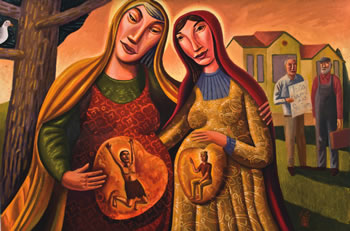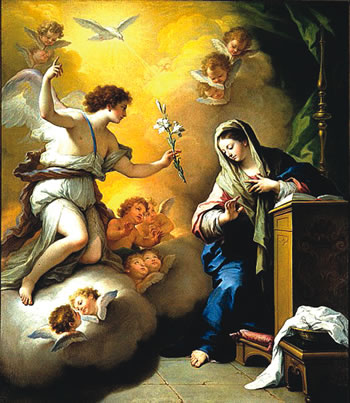Mary for Today – Part 8
Luke
Annunciation: Mary is not a disciple in the historical sense that she accompanied Jesus during his ministry, but in the sense that she heard the word of God and acted on it. In Luke’s theology the faith that marks a genuine disciple consists in hearing and acting on God’s word. This reminds us of Elizabeth’s earlier words, blessing Mary for her believing, because the things said to her by the Lord would reach fulfilment. The annunciation scene depicts Mary with a mood of celebration as a hearer and doer of God’s word.
The overarching purpose of this account is to disclose to the reader at the outset the truth about Jesus’ messianic identity. Using titles of Christology and language developed by the church after the resurrection, (‘Son of the Most High’) the scene vividly dramatises the theological point that Jesus did not just become the Son of God after his death (Paul), or even at his baptism (Mark) but is Son of God from his very conception in this world. At the same time, by making Mary the central character, Luke invites reflection on Mary’s faith and her action in her own right. The text has been fundamental in influencing the development of honouring Mary.
Conceived of the Holy Spirit: ‘Overshadowing’ always means the Spirit of God drawing near and passing by to save and protect. God’s Spirit is a creative power in the begetting of Jesus. We look to the text for religious meaning, not physical or what actually happened historically. That we shall never know because the Gospel writers drew on the details of the Old Testament annunciation accounts to relate this sacred moment of choice. Mary is called to trust, for she will be empowered and protected by God.
In the opening scenes of Genesis, the Spirit of God blows like a mighty wind over the dark waters and the world came into being. At this new moment of the renewal of creation, the Spirit is on the move again. At Easter, by the Spirit, Jesus is raised from the dead and made Son of God in power, so the same life-giving Spirit brings life from both empty tombs and empty wombs.
Mary’s Yes! Divine freedom does not override created human freedom but waits upon our response. Mary responds with courage and with joy and prophecy to this unexpected call. In affirming her own identity as handmaid of the Lord in her assent, Be it done to me according to your word, she makes a radical act of trust in God, based on a bedrock conviction that God is faithful.
Here we have the story of a young peasant girl who discerns the voice of God in her life commissioning her to a momentous task. Exercising independent thought and action, she asks questions, takes counsel with her own self, and makes a self-determining act of choice. It changes her life, and as a woman of Spirit, she embarks on the task of partnering God in the work of redemption. Like any prophet, she asserts herself before God saying, “Here I am.” “It is her word and faith that makes possible God’s entrance into history” (Reuther).
Visitation: Joy in the Revolution of God (Lk 1:39-56). In this meeting Mary sings out a prophetic song of praise to God, the Magnificat. This song can barely contain Mary’s joy over the liberation coming to fruition in herself and the world through the creative power of the Spirit. Her no to oppression completes her yes to solidarity with the project of the reign of God. She sings the great NT song of liberation – personal and social, moral and economic – a revolutionary document of intense conflict and victory, praising God’s actions on behalf of marginal, exploited peoples.

The Visitation - from a Triptych by Jim Janknegt
www.artsandfaith.com
The other figure in the drama is Elizabeth. Having resigned herself to living with disappointment over never having a child, Elizabeth now has to deal with an ‘unexpected blessing’. Mary in turn has to figure out how to deal with a blessing that causes more problems than it solves. Like many young women in similar straits, she leaves town to seek the wisdom of an elderly relative. This older woman had been faithfully walking in the ways of God for many long years. She stands in the list of barren Hebrew matriarchs, Sarah, Rebekah, Rachel, Samson’s mother, and Hannah, symbol of barren Jerusalem. All signal God’s vindication of the lowly with stories of humiliated women blessed by conceiving and bearing a son. A long life of attentiveness to the Spirit enables Elizabeth to conceive this child, not as a gift for Zechariah or her people alone (as patriarchal law would have it), but signifying God’s regard for her as a loved and valuable person, “for so the Lord has done for me.”
While Luke is careful in not giving Elizabeth the title of prophet, as one filled with the Holy Spirit she functions as one. Other famous women who helped deliver Israel from peril speak as she does. Deborah praises Jael, slayer of their enemy, “Most blessed be Jael among women” and Judith is praised
“O daughter, you are blessed by the Most High God above all other women on earth.” Elizabeth’s word of praise of Mary joins her young cousin in solidarity with a long heritage of women whose creative action, undertaken in the power of the Spirit, brings liberation in God’s name.
Mary remains with Elizabeth for three months (cf. 2 Sm 6, Ark of the Covenant). The support they share with each other enables them to mother the next generation of prophets, the Precursor and the Saviour. On balance, Elizabeth stands as a moving embodiment of the wisdom and care that older women can offer younger ones, who, brave as they are, are just starting out on their journey through life. Her presence assures the younger woman that she does not face the uncertain future alone. Elizabeth’s mature experience sustains the new venture.
Reference:
Kathleen Coyle and Elizabeth Johnson.

 Entries(RSS)
Entries(RSS)